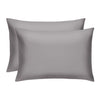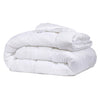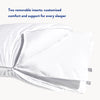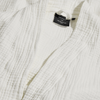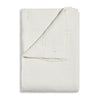The Daily Miracle
What Goes Inside a Duvet Cover?
Published
December 14, 2022
Author
Bridget Reed

Duvets are the epitome of all things luxurious, warm, and cozy; their luscious cover and warm insert make for the perfect bedding. While some prefer their trusted comforter, duvets shouldn’t be forgotten.
To understand what goes inside a duvet cover, you must know the anatomy of the duvet; it explains a lot about the product, its pros and cons, and if it’s the right type of bedding for you. Considering the average adult spends seven to nine hours a day sleeping, you want to find bedding that meets all your bedtime desires.
If you’ve spent most of your life not really prioritizing your bedding, it may be time for a change. Your bedding plays a vital role in your sleep habits, which play a vital role in your overall health. If you’ve had issues sleeping, your bedding may be to blame. While we’re clarifying any of your duvet misconceptions, we hope to help you make an important decision: which type of bedding you should buy next.
Keep reading — we have all the answers below.
History of the Duvet
Duvets first hit the market in the 1960s and were quite the rave. However, the history of duvets began long before then. Duvets began in Europe and were discovered by Sir Terence Conran. Sir Terence Conran began importing and selling duvets to Britain from Sweden in the 1960s, and they’ve since taken the UK and the US by storm.
People love the convenience of its wash process — duvets were originally marketed as “the 10-second bed.” Not to mention the versatility; duvet covers are easily interchangeable to accommodate any mood (or season).
As the bedding industry has grown, so has the demand for reliable, high-quality duvets. While we’re here to tell you about what goes inside a duvet, we also want to inform you of some vital information surrounding duvets in general.
The Anatomy of a Duvet
Duvets are composed of two parts, the cover and the insert. What goes inside a duvet cover is a duvet insert, and the two pieces are secured together with ties or buttons.
Think of a duvet cover like a pillowcase; the cover protects the insert from germs and bacteria. Unless you have a self-cleaning, antibacterial comforter, chances are your bedding is much dirtier than you realize.
Like pillows, washing duvet inserts can be tricky, as duvet inserts are big and become heavy when wet; frequent washes can add wear and tear to your washing appliances. A duvet cover makes wash-day quick and easy.
What Is a Duvet Insert Made Of?
Duck and goose down (feathers) were the original materials of a duvet insert, but it’s not uncommon to see duvets made from other materials to accommodate everyone's needs.
Duvets (and comforters) made from duck or goose down are pricey, but nowadays, you can get an insert with synthetic materials or less-expensive natural options (like silk or wool.)
Duvets keep you warm, they’re versatile, and their clean-up isn’t as involved as a traditional comforter.
How Warm Is a Duvet?
The warmth of a duvet depends on the materials of the cover and insert. A thicker cover with a warmer material (like duck down) inside will result in a (very) toasty night's sleep.
If you’re seeking the warmest duvet option possible, it’s best to get a duck or goose down insert with a thicker cover; real feathers are very warm and insulating. However, if you’re someone that sleeps hot (or has issues like hot feet at night), you may want to consider a cooler option. For example, temperature-regulating sheets, pillowcases, and comforters are great for people who can’t stay cool while sleeping.
Duvets aren’t just for the cold-blooded; even if you’re a hot sleeper, you can still enjoy the conveniences a duvet offers; you just have to know how to buy. Opt for fabrics labeled “extra breathable” (500-thread count sateen weave is a great option).
Try to avoid duck or goose down, especially if you have allergies to feathers. Instead, try out a more breathable cotton insert.
How To Choose the Best Duvet
Now that you know the anatomy of a duvet, how warm it’ll keep you, and what to avoid, let’s talk about choosing the best one for you!
Ask yourself these questions:
Am I a hot sleeper?
Opt for more breathable fabrics and lighter materials if you're a hot sleeper.
Am I indecisive about my bedding?
If you like changing your bedroom decor often, duvets offer the freedom of switching out the cover for a fraction of the cost compared to buying a whole comforter.
How frequently do I wash my bedding?
While some people are sticklers about their bedding always being clean, others aren’t as strict with themselves. If you appreciate freshly washed sheets and blankets, you may enjoy the easy clean-up duvets offer.
Best Duvet for Cold Sleepers
If you need an extra layer of warmth, get a duvet that will provide that.
The warmest duvets are wool covers with a feather insert. Both are natural materials which can affect their price, but if you want to treat yourself, this might be your answer.
Best Duvet for Warm Sleepers
Night sweats are all too familiar to far too many. It’s common to have an issue staying cool at night, which is why products are specially formulated to help keep your night sweats at bay.
To avoid overheating at night, stick to a breathable fabric like cotton and an insert of a synthetic material like microfiber.
Best Duvet for Fewer Chores
Washing bedding is a critical part of promoting better sleep, cleaner skin, and healthier air. However, doing chores is hardly anyone’s idea of a fun way to spend the weekend. It can be hard to keep up with weekly washes. Instead, opt for antibacterial bedding for three times less laundry and a luxurious feel.
What Are the Advantages of a Duvet?
The main advantage of duvets is that the cover provides adequate protection for the insert, resulting in fewer washes. While some can handle machine washes, many inserts are more delicate and may not hold up against routine washes.
It’s recommended to wash your bedding every four to six days. To avoid frequent washes, opt for a self-cleaning, antibacterial duvet cover.
Antibacterial bedding is infused with natural silver to prevent 99.9% of bacteria growth. Natural silver contains ions that are highly effective at eliminating bacteria. These ions attack unwanted germs in the cell walls, and once the walls are damaged, the entire cell dies.
Other Options Besides a Duvet
Duvets aren’t for everyone, and that’s okay. If you’ve concluded they aren’t your thing, there are still endless options. Comforters are just as prominent in the bedding world as duvets, meaning you’ll find one that works for you. The Miracle Made Comforter is 100% vegan, all-natural, and naturally antibacterial. It’s soft as a cloud, thanks to 500-thread count Supima cotton.
Hello, Cozy Nights
Duvets are popular products in the bedding industry, and rightfully so. They’re versatile, warm, and very convenient. Whether you’ve decided duvets are still your #1 choice or that it’s time to give comforters a try. Either way, we’re sure there are plenty of warm, cozy nights ahead.
Sources:
How Much Sleep Do We Really Need | Sleep Foundation


